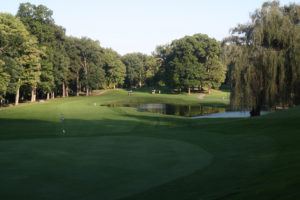Length: Ranges from championship tees of 6,771 yards, to forward at 5,253 yards.
Most memorable: The greens are tricky, plain and simple. Many are large, some have tiers, but big undulations are not part of the equation. So at first glance the putting surfaces appear rather tame, which causes an assumption the ball won’t break much. Wrong. Play more break than you’d expect or you’ll be missing the cup every time and be suffering on the scorecard. When in doubt, local knowledge says the putt will break away from the clubhouse.
Picture this: Hole 16 is an attractive par 3 forced carry over water. The green is large and receptive, which helps golfers mentally get over the fact you still must hit a good shot off the tee to reach safely.
 Risky business: Not often is a par 4 a risk-reward hole, but is in the case of No. 14. The 447-yard hole has a rise in the fairway that blocks the view of water up the entire left side from about 180 yards on into the green, as well as no view of what little fairway is available to the right – so a layup is typically encouraged to avoid the pond. That leaves a much longer approach shot to an elevated green that requires an extra club in the first place, and perhaps two clubs if a west wind is kicking up. All in all, walking away with par is outstanding and a bogey isn’t bad. This is followed up by another blind tee shot on 15.
Risky business: Not often is a par 4 a risk-reward hole, but is in the case of No. 14. The 447-yard hole has a rise in the fairway that blocks the view of water up the entire left side from about 180 yards on into the green, as well as no view of what little fairway is available to the right – so a layup is typically encouraged to avoid the pond. That leaves a much longer approach shot to an elevated green that requires an extra club in the first place, and perhaps two clubs if a west wind is kicking up. All in all, walking away with par is outstanding and a bogey isn’t bad. This is followed up by another blind tee shot on 15.
Overview: Dunham Hills is a fun track and beautiful property to enjoy. It’s a parkland style course with rolling hills and valleys, plus a variety of fairways that go uphill and downhill – all variables which combine to cause side-hill stances on many occasions. The course is loaded with trees, but they are spaced out enough it doesn’t feel as suffocating as some courses. The last four holes are listed as some of the easiest handicap holes on the back nine, so a strong finish can be had. Above all, accuracy is paramount.
www.dunhamhills.com

